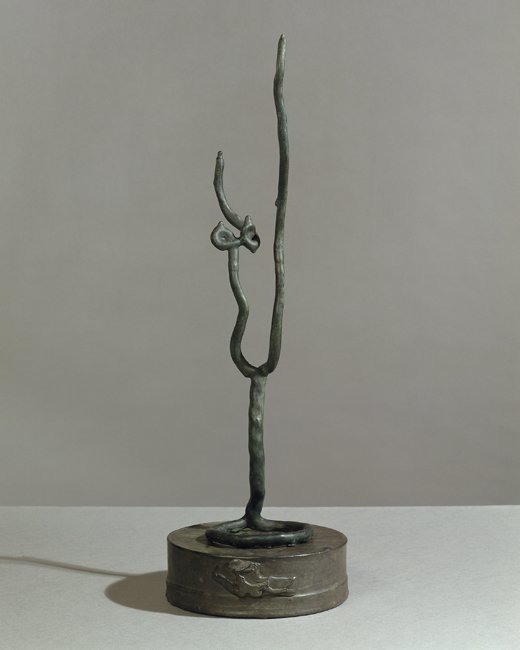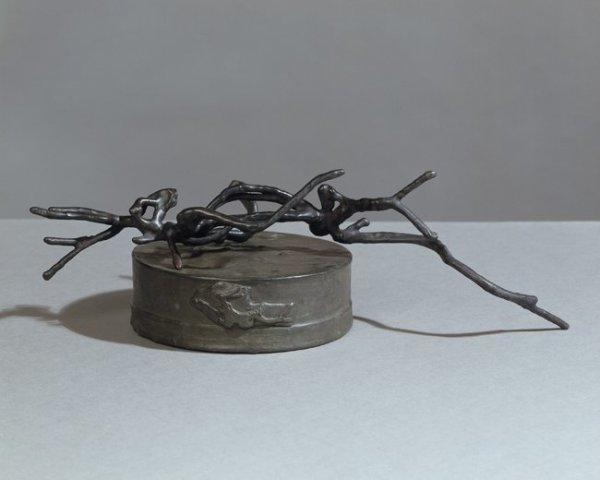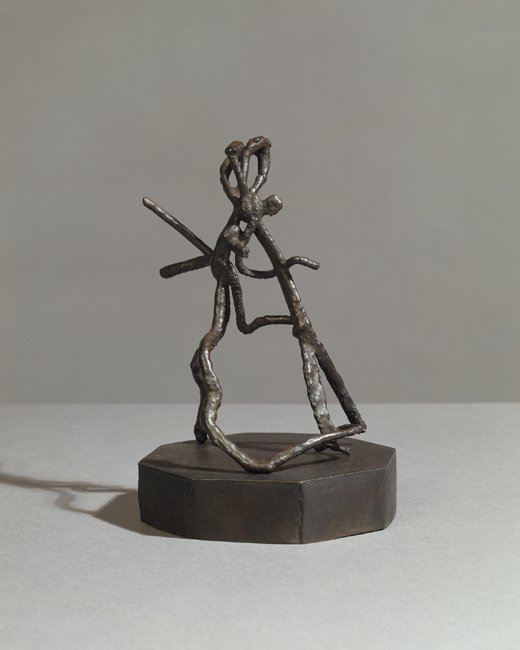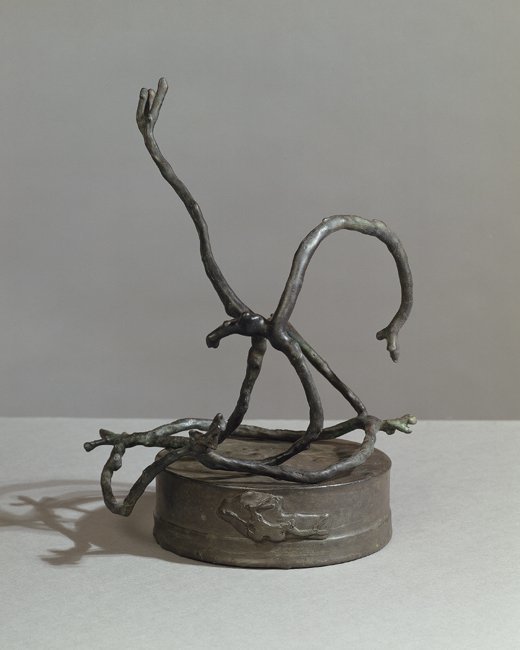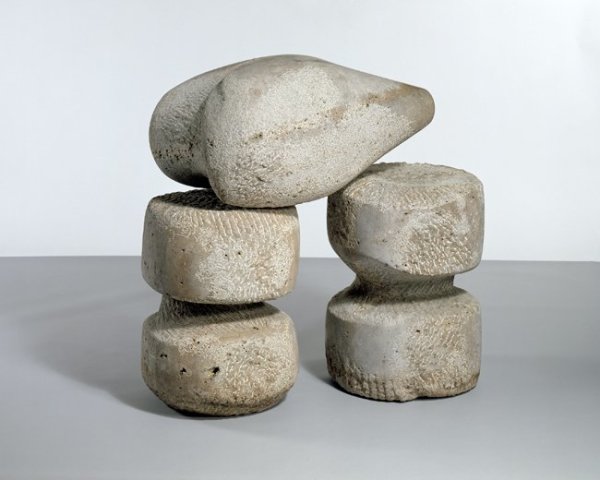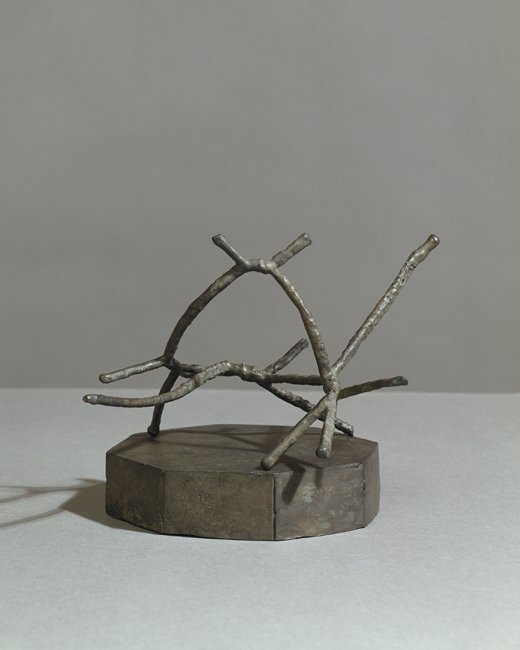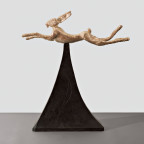Biography
This is the first showing of Barry Flanagan’s recent linear sculptures in bronze, a series of small sculptures he began two years ago, most of which are unique. They are among the most tactile objects Flanagan has yet made, inviting the viewer to pick them up just for the pleasure of handling the smooth linear shapes. As Paul Levy points out in his catalogue introduction, everything Flanagan has ever done ’seems to have this element of playfulness, of wit and good humour.’ And he continues: ‘Sometimes there’s mischief, sometimes sweetness, sometimes jokiness and jest - but always play. There’s never a whiff of pretension in Flanagan’s work – in his hands bronzes can be mighty, heroic even, but never pompous.’ These small bronzes demonstrate Flanagan’s continuing awareness of forms in nature, whether in the shape of the bounding hare, trees bending under the force of a gale, or the delicate movements of crawling insects. The pleasure he takes in the ingenuity of organic structures are also investigations into the nature of the armature. Flanagan has always been a superb draughtsman, and those skills are fully demonstrated in the way in which he fashions lengths of pipe-cleaners into forms that simultaneously hide and reveal their subject matter. The pipe-cleaner sculptures are then dipped in wax and cast in bronze. The bronzes are a form of drawing in space, and the stone carvings are about another way in which a sculptor uses his hands - modelling. Flanagan began working with stone in the mid-1970s, but the larger sculptures presented here were made in the early 1980s, carved by Italian stone masons from plaster or clay models made by the artist. These forms, which fold in on themselves like flesh or dough, are equally inviting to the touch. Like the bronzes, they are primarily tactile objects which demand an equally physical reaction on the part of the viewer. Flanagan uses stone, as he uses bronze, to subvert the traditional concept of the heroic and the monumental, and to redefine the relationship between the sculptor and his materials.
继续作品
-
 Barry Flanagan, Dance DAF #54, 2003
bronze with circular base 31/03
16 1/2 x 3 1/2 x 3 1/2 in / 42 x 8.9 x 8.9 cm
%3Cdiv%20class%3D%22artist%22%3E%3Cstrong%3EBarry%20Flanagan%3C/strong%3E%3C/div%3E%0D%3Cdiv%20class%3D%22title%22%3E%3Cem%3EDance%20DAF%20%2354%3C/em%3E%2C%202003%3C/div%3E%0D%3Cdiv%20class%3D%22medium%22%3Ebronze%20with%20circular%20base%2031/03%3C/div%3E%0D%3Cdiv%20class%3D%22dimensions%22%3E16%201/2%20x%203%201/2%20x%203%201/2%20in%20/%2042%20x%208.9%20x%208.9%20cm%3C/div%3E
Barry Flanagan, Dance DAF #54, 2003
bronze with circular base 31/03
16 1/2 x 3 1/2 x 3 1/2 in / 42 x 8.9 x 8.9 cm
%3Cdiv%20class%3D%22artist%22%3E%3Cstrong%3EBarry%20Flanagan%3C/strong%3E%3C/div%3E%0D%3Cdiv%20class%3D%22title%22%3E%3Cem%3EDance%20DAF%20%2354%3C/em%3E%2C%202003%3C/div%3E%0D%3Cdiv%20class%3D%22medium%22%3Ebronze%20with%20circular%20base%2031/03%3C/div%3E%0D%3Cdiv%20class%3D%22dimensions%22%3E16%201/2%20x%203%201/2%20x%203%201/2%20in%20/%2042%20x%208.9%20x%208.9%20cm%3C/div%3E -
 Barry Flanagan, Dragon II, 2002
bronze (Unique)
10 1/4 x 13 x 9 in / 26 x 33 x 22.8 cm
%3Cdiv%20class%3D%22artist%22%3E%3Cstrong%3EBarry%20Flanagan%3C/strong%3E%3C/div%3E%0D%3Cdiv%20class%3D%22title%22%3E%3Cem%3EDragon%20II%3C/em%3E%2C%202002%3C/div%3E%0D%3Cdiv%20class%3D%22medium%22%3Ebronze%20%28Unique%29%3C/div%3E%0D%3Cdiv%20class%3D%22dimensions%22%3E10%201/4%20x%2013%20x%209%20in%20/%2026%20x%2033%20x%2022.8%20cm%3C/div%3E
Barry Flanagan, Dragon II, 2002
bronze (Unique)
10 1/4 x 13 x 9 in / 26 x 33 x 22.8 cm
%3Cdiv%20class%3D%22artist%22%3E%3Cstrong%3EBarry%20Flanagan%3C/strong%3E%3C/div%3E%0D%3Cdiv%20class%3D%22title%22%3E%3Cem%3EDragon%20II%3C/em%3E%2C%202002%3C/div%3E%0D%3Cdiv%20class%3D%22medium%22%3Ebronze%20%28Unique%29%3C/div%3E%0D%3Cdiv%20class%3D%22dimensions%22%3E10%201/4%20x%2013%20x%209%20in%20/%2026%20x%2033%20x%2022.8%20cm%3C/div%3E -
 Barry Flanagan, Feast of Tahiti, 2002
bronze 4.5Kg / 10lbs
15 1/8 x 7 3/8 x 5 in / 38.4 x 18.7 x 12.7 cm
%3Cdiv%20class%3D%22artist%22%3E%3Cstrong%3EBarry%20Flanagan%3C/strong%3E%3C/div%3E%0D%3Cdiv%20class%3D%22title%22%3E%3Cem%3EFeast%20of%20Tahiti%3C/em%3E%2C%202002%3C/div%3E%0D%3Cdiv%20class%3D%22medium%22%3Ebronze%204.5Kg%20/%2010lbs%3C/div%3E%0D%3Cdiv%20class%3D%22dimensions%22%3E15%201/8%20x%207%203/8%20x%205%20in%20/%2038.4%20x%2018.7%20x%2012.7%20cm%3C/div%3E
Barry Flanagan, Feast of Tahiti, 2002
bronze 4.5Kg / 10lbs
15 1/8 x 7 3/8 x 5 in / 38.4 x 18.7 x 12.7 cm
%3Cdiv%20class%3D%22artist%22%3E%3Cstrong%3EBarry%20Flanagan%3C/strong%3E%3C/div%3E%0D%3Cdiv%20class%3D%22title%22%3E%3Cem%3EFeast%20of%20Tahiti%3C/em%3E%2C%202002%3C/div%3E%0D%3Cdiv%20class%3D%22medium%22%3Ebronze%204.5Kg%20/%2010lbs%3C/div%3E%0D%3Cdiv%20class%3D%22dimensions%22%3E15%201/8%20x%207%203/8%20x%205%20in%20/%2038.4%20x%2018.7%20x%2012.7%20cm%3C/div%3E -
 Barry Flanagan, Hare Theme DAF #60, 2003
bronze (unique) with circular base 26/03
5 1/4 x 11 1/2 x 6 in / 13.3 x 29.2 x 15.2 cm
%3Cdiv%20class%3D%22artist%22%3E%3Cstrong%3EBarry%20Flanagan%3C/strong%3E%3C/div%3E%0D%3Cdiv%20class%3D%22title%22%3E%3Cem%3EHare%20Theme%20DAF%20%2360%3C/em%3E%2C%202003%3C/div%3E%0D%3Cdiv%20class%3D%22medium%22%3Ebronze%20%28unique%29%20with%20circular%20base%2026/03%3C/div%3E%0D%3Cdiv%20class%3D%22dimensions%22%3E5%201/4%20x%2011%201/2%20x%206%20in%20/%2013.3%20x%2029.2%20x%2015.2%20cm%3C/div%3E
Barry Flanagan, Hare Theme DAF #60, 2003
bronze (unique) with circular base 26/03
5 1/4 x 11 1/2 x 6 in / 13.3 x 29.2 x 15.2 cm
%3Cdiv%20class%3D%22artist%22%3E%3Cstrong%3EBarry%20Flanagan%3C/strong%3E%3C/div%3E%0D%3Cdiv%20class%3D%22title%22%3E%3Cem%3EHare%20Theme%20DAF%20%2360%3C/em%3E%2C%202003%3C/div%3E%0D%3Cdiv%20class%3D%22medium%22%3Ebronze%20%28unique%29%20with%20circular%20base%2026/03%3C/div%3E%0D%3Cdiv%20class%3D%22dimensions%22%3E5%201/4%20x%2011%201/2%20x%206%20in%20/%2013.3%20x%2029.2%20x%2015.2%20cm%3C/div%3E -
 Barry Flanagan, Hare Theme DAF #63, 2003
bronze (unique) with circular base 24/03
7 1/4 x 10 3/4 x 7 1/2 in / 18.4 x 27.3 x 19 cm
%3Cdiv%20class%3D%22artist%22%3E%3Cstrong%3EBarry%20Flanagan%3C/strong%3E%3C/div%3E%0D%3Cdiv%20class%3D%22title%22%3E%3Cem%3EHare%20Theme%20DAF%20%2363%3C/em%3E%2C%202003%3C/div%3E%0D%3Cdiv%20class%3D%22medium%22%3Ebronze%20%28unique%29%20with%20circular%20base%2024/03%3C/div%3E%0D%3Cdiv%20class%3D%22dimensions%22%3E7%201/4%20x%2010%203/4%20x%207%201/2%20in%20/%2018.4%20x%2027.3%20x%2019%20cm%3C/div%3E
Barry Flanagan, Hare Theme DAF #63, 2003
bronze (unique) with circular base 24/03
7 1/4 x 10 3/4 x 7 1/2 in / 18.4 x 27.3 x 19 cm
%3Cdiv%20class%3D%22artist%22%3E%3Cstrong%3EBarry%20Flanagan%3C/strong%3E%3C/div%3E%0D%3Cdiv%20class%3D%22title%22%3E%3Cem%3EHare%20Theme%20DAF%20%2363%3C/em%3E%2C%202003%3C/div%3E%0D%3Cdiv%20class%3D%22medium%22%3Ebronze%20%28unique%29%20with%20circular%20base%2024/03%3C/div%3E%0D%3Cdiv%20class%3D%22dimensions%22%3E7%201/4%20x%2010%203/4%20x%207%201/2%20in%20/%2018.4%20x%2027.3%20x%2019%20cm%3C/div%3E -
 Barry Flanagan, Hare Theme DAF #69, 2003
bronze (unique) with circular base 25/03
5 3/8 x 14 1/4 x 4 1/4 in / 13.6 x 36.2 x 10.8 cm
%3Cdiv%20class%3D%22artist%22%3E%3Cstrong%3EBarry%20Flanagan%3C/strong%3E%3C/div%3E%0D%3Cdiv%20class%3D%22title%22%3E%3Cem%3EHare%20Theme%20DAF%20%2369%3C/em%3E%2C%202003%3C/div%3E%0D%3Cdiv%20class%3D%22medium%22%3Ebronze%20%28unique%29%20with%20circular%20base%2025/03%3C/div%3E%0D%3Cdiv%20class%3D%22dimensions%22%3E5%203/8%20x%2014%201/4%20x%204%201/4%20in%20/%2013.6%20x%2036.2%20x%2010.8%20cm%3C/div%3E
Barry Flanagan, Hare Theme DAF #69, 2003
bronze (unique) with circular base 25/03
5 3/8 x 14 1/4 x 4 1/4 in / 13.6 x 36.2 x 10.8 cm
%3Cdiv%20class%3D%22artist%22%3E%3Cstrong%3EBarry%20Flanagan%3C/strong%3E%3C/div%3E%0D%3Cdiv%20class%3D%22title%22%3E%3Cem%3EHare%20Theme%20DAF%20%2369%3C/em%3E%2C%202003%3C/div%3E%0D%3Cdiv%20class%3D%22medium%22%3Ebronze%20%28unique%29%20with%20circular%20base%2025/03%3C/div%3E%0D%3Cdiv%20class%3D%22dimensions%22%3E5%203/8%20x%2014%201/4%20x%204%201/4%20in%20/%2013.6%20x%2036.2%20x%2010.8%20cm%3C/div%3E -
 Barry Flanagan, Landscape Theme No.2, 2002
bronze (unique) with octagonal base 4/02
6 1/4 x 5 x 3 1/4 in / 15.8 x 12.8 x 8.2 cm
%3Cdiv%20class%3D%22artist%22%3E%3Cstrong%3EBarry%20Flanagan%3C/strong%3E%3C/div%3E%0D%3Cdiv%20class%3D%22title%22%3E%3Cem%3ELandscape%20Theme%20No.2%3C/em%3E%2C%202002%3C/div%3E%0D%3Cdiv%20class%3D%22medium%22%3Ebronze%20%28unique%29%20with%20octagonal%20base%204/02%3C/div%3E%0D%3Cdiv%20class%3D%22dimensions%22%3E6%201/4%20x%205%20x%203%201/4%20in%20/%2015.8%20x%2012.8%20x%208.2%20cm%3C/div%3E
Barry Flanagan, Landscape Theme No.2, 2002
bronze (unique) with octagonal base 4/02
6 1/4 x 5 x 3 1/4 in / 15.8 x 12.8 x 8.2 cm
%3Cdiv%20class%3D%22artist%22%3E%3Cstrong%3EBarry%20Flanagan%3C/strong%3E%3C/div%3E%0D%3Cdiv%20class%3D%22title%22%3E%3Cem%3ELandscape%20Theme%20No.2%3C/em%3E%2C%202002%3C/div%3E%0D%3Cdiv%20class%3D%22medium%22%3Ebronze%20%28unique%29%20with%20octagonal%20base%204/02%3C/div%3E%0D%3Cdiv%20class%3D%22dimensions%22%3E6%201/4%20x%205%20x%203%201/4%20in%20/%2015.8%20x%2012.8%20x%208.2%20cm%3C/div%3E -
 Barry Flanagan, Theme DAF #67, 2003
bronze (unique) with circular base 34/03
10 1/4 x 8 1/2 x 7 in / 26 x 21.6 x 17.8 cm
%3Cdiv%20class%3D%22artist%22%3E%3Cstrong%3EBarry%20Flanagan%3C/strong%3E%3C/div%3E%0D%3Cdiv%20class%3D%22title%22%3E%3Cem%3ETheme%20DAF%20%2367%3C/em%3E%2C%202003%3C/div%3E%0D%3Cdiv%20class%3D%22medium%22%3Ebronze%20%28unique%29%20with%20circular%20base%2034/03%3C/div%3E%0D%3Cdiv%20class%3D%22dimensions%22%3E10%201/4%20x%208%201/2%20x%207%20in%20/%2026%20x%2021.6%20x%2017.8%20cm%3C/div%3E
Barry Flanagan, Theme DAF #67, 2003
bronze (unique) with circular base 34/03
10 1/4 x 8 1/2 x 7 in / 26 x 21.6 x 17.8 cm
%3Cdiv%20class%3D%22artist%22%3E%3Cstrong%3EBarry%20Flanagan%3C/strong%3E%3C/div%3E%0D%3Cdiv%20class%3D%22title%22%3E%3Cem%3ETheme%20DAF%20%2367%3C/em%3E%2C%202003%3C/div%3E%0D%3Cdiv%20class%3D%22medium%22%3Ebronze%20%28unique%29%20with%20circular%20base%2034/03%3C/div%3E%0D%3Cdiv%20class%3D%22dimensions%22%3E10%201/4%20x%208%201/2%20x%207%20in%20/%2026%20x%2021.6%20x%2017.8%20cm%3C/div%3E -
 Barry Flanagan, Theme DAF #70, 2003
bronze (unique) with circular base 33/03
10 x 9 1/4 x 10 1/4 in / 25.4 x 23.5 x 26 cm
%3Cdiv%20class%3D%22artist%22%3E%3Cstrong%3EBarry%20Flanagan%3C/strong%3E%3C/div%3E%0D%3Cdiv%20class%3D%22title%22%3E%3Cem%3ETheme%20DAF%20%2370%3C/em%3E%2C%202003%3C/div%3E%0D%3Cdiv%20class%3D%22medium%22%3Ebronze%20%28unique%29%20with%20circular%20base%2033/03%3C/div%3E%0D%3Cdiv%20class%3D%22dimensions%22%3E10%20x%209%201/4%20x%2010%201/4%20in%20/%2025.4%20x%2023.5%20x%2026%20cm%3C/div%3E
Barry Flanagan, Theme DAF #70, 2003
bronze (unique) with circular base 33/03
10 x 9 1/4 x 10 1/4 in / 25.4 x 23.5 x 26 cm
%3Cdiv%20class%3D%22artist%22%3E%3Cstrong%3EBarry%20Flanagan%3C/strong%3E%3C/div%3E%0D%3Cdiv%20class%3D%22title%22%3E%3Cem%3ETheme%20DAF%20%2370%3C/em%3E%2C%202003%3C/div%3E%0D%3Cdiv%20class%3D%22medium%22%3Ebronze%20%28unique%29%20with%20circular%20base%2033/03%3C/div%3E%0D%3Cdiv%20class%3D%22dimensions%22%3E10%20x%209%201/4%20x%2010%201/4%20in%20/%2025.4%20x%2023.5%20x%2026%20cm%3C/div%3E -
 Barry Flanagan, Troubador in the Chicken Coop, 2002
bronze (Unique)
10 x 7 1/2 x 6 in / 25.4 x 19 x 15.2 cm
%3Cdiv%20class%3D%22artist%22%3E%3Cstrong%3EBarry%20Flanagan%3C/strong%3E%3C/div%3E%0D%3Cdiv%20class%3D%22title%22%3E%3Cem%3ETroubador%20in%20the%20Chicken%20Coop%3C/em%3E%2C%202002%3C/div%3E%0D%3Cdiv%20class%3D%22medium%22%3Ebronze%20%28Unique%29%3C/div%3E%0D%3Cdiv%20class%3D%22dimensions%22%3E10%20x%207%201/2%20x%206%20in%20/%2025.4%20x%2019%20x%2015.2%20cm%3C/div%3E
Barry Flanagan, Troubador in the Chicken Coop, 2002
bronze (Unique)
10 x 7 1/2 x 6 in / 25.4 x 19 x 15.2 cm
%3Cdiv%20class%3D%22artist%22%3E%3Cstrong%3EBarry%20Flanagan%3C/strong%3E%3C/div%3E%0D%3Cdiv%20class%3D%22title%22%3E%3Cem%3ETroubador%20in%20the%20Chicken%20Coop%3C/em%3E%2C%202002%3C/div%3E%0D%3Cdiv%20class%3D%22medium%22%3Ebronze%20%28Unique%29%3C/div%3E%0D%3Cdiv%20class%3D%22dimensions%22%3E10%20x%207%201/2%20x%206%20in%20/%2025.4%20x%2019%20x%2015.2%20cm%3C/div%3E -
 Barry Flanagan, Untitled, 1984
Tuscan travertine (travertino noce) (stone carving) three parts / carved by Ghelardini
36 x 41 x 20 in / 91.4 x 104.1 x 50.8 cm
Barry Flanagan, Untitled, 1984
Tuscan travertine (travertino noce) (stone carving) three parts / carved by Ghelardini
36 x 41 x 20 in / 91.4 x 104.1 x 50.8 cm
-
 Barry Flanagan, Wave, 2002
bronze
6 1/2 x 9 1/4 x 6 1/2 in / 16.5 x 23.5 x 16.5 cm
%3Cdiv%20class%3D%22artist%22%3E%3Cstrong%3EBarry%20Flanagan%3C/strong%3E%3C/div%3E%0D%3Cdiv%20class%3D%22title%22%3E%3Cem%3EWave%3C/em%3E%2C%202002%3C/div%3E%0D%3Cdiv%20class%3D%22medium%22%3Ebronze%3C/div%3E%0D%3Cdiv%20class%3D%22dimensions%22%3E6%201/2%20x%209%201/4%20x%206%201/2%20in%20/%2016.5%20x%2023.5%20x%2016.5%20cm%3C/div%3E
Barry Flanagan, Wave, 2002
bronze
6 1/2 x 9 1/4 x 6 1/2 in / 16.5 x 23.5 x 16.5 cm
%3Cdiv%20class%3D%22artist%22%3E%3Cstrong%3EBarry%20Flanagan%3C/strong%3E%3C/div%3E%0D%3Cdiv%20class%3D%22title%22%3E%3Cem%3EWave%3C/em%3E%2C%202002%3C/div%3E%0D%3Cdiv%20class%3D%22medium%22%3Ebronze%3C/div%3E%0D%3Cdiv%20class%3D%22dimensions%22%3E6%201/2%20x%209%201/4%20x%206%201/2%20in%20/%2016.5%20x%2023.5%20x%2016.5%20cm%3C/div%3E -
 Barry Flanagan, Landscape Theme No.4, 2002
bronze (unique) with octagonal base 12/02
4 x 6 1/2 x 5 in / 10 x 16.5 x 12.7 cm
%3Cdiv%20class%3D%22artist%22%3E%3Cstrong%3EBarry%20Flanagan%3C/strong%3E%3C/div%3E%0D%3Cdiv%20class%3D%22title%22%3E%3Cem%3ELandscape%20Theme%20No.4%3C/em%3E%2C%202002%3C/div%3E%0D%3Cdiv%20class%3D%22medium%22%3Ebronze%20%28unique%29%20with%20octagonal%20base%2012/02%3C/div%3E%0D%3Cdiv%20class%3D%22dimensions%22%3E4%20x%206%201/2%20x%205%20in%20/%2010%20x%2016.5%20x%2012.7%20cm%3C/div%3E
Barry Flanagan, Landscape Theme No.4, 2002
bronze (unique) with octagonal base 12/02
4 x 6 1/2 x 5 in / 10 x 16.5 x 12.7 cm
%3Cdiv%20class%3D%22artist%22%3E%3Cstrong%3EBarry%20Flanagan%3C/strong%3E%3C/div%3E%0D%3Cdiv%20class%3D%22title%22%3E%3Cem%3ELandscape%20Theme%20No.4%3C/em%3E%2C%202002%3C/div%3E%0D%3Cdiv%20class%3D%22medium%22%3Ebronze%20%28unique%29%20with%20octagonal%20base%2012/02%3C/div%3E%0D%3Cdiv%20class%3D%22dimensions%22%3E4%20x%206%201/2%20x%205%20in%20/%2010%20x%2016.5%20x%2012.7%20cm%3C/div%3E -
 Barry Flanagan, Organic Structure, 2002
bronze
4 3/4 x 12 1/4 x 5 in / 12 x 31 X 12.7 cm
%3Cdiv%20class%3D%22artist%22%3E%3Cstrong%3EBarry%20Flanagan%3C/strong%3E%3C/div%3E%0D%3Cdiv%20class%3D%22title%22%3E%3Cem%3EOrganic%20Structure%3C/em%3E%2C%202002%3C/div%3E%0D%3Cdiv%20class%3D%22medium%22%3Ebronze%3C/div%3E%0D%3Cdiv%20class%3D%22dimensions%22%3E4%203/4%20x%2012%201/4%20x%205%20in%20/%2012%20x%2031%20X%2012.7%20cm%3C/div%3E
Barry Flanagan, Organic Structure, 2002
bronze
4 3/4 x 12 1/4 x 5 in / 12 x 31 X 12.7 cm
%3Cdiv%20class%3D%22artist%22%3E%3Cstrong%3EBarry%20Flanagan%3C/strong%3E%3C/div%3E%0D%3Cdiv%20class%3D%22title%22%3E%3Cem%3EOrganic%20Structure%3C/em%3E%2C%202002%3C/div%3E%0D%3Cdiv%20class%3D%22medium%22%3Ebronze%3C/div%3E%0D%3Cdiv%20class%3D%22dimensions%22%3E4%203/4%20x%2012%201/4%20x%205%20in%20/%2012%20x%2031%20X%2012.7%20cm%3C/div%3E -
 Barry Flanagan, Prom, 2001
bronze
14 7/8 x 5 x 6 3/4 in / 37.7 x 12.7 x 17.1 cm
%3Cdiv%20class%3D%22artist%22%3E%3Cstrong%3EBarry%20Flanagan%3C/strong%3E%3C/div%3E%0D%3Cdiv%20class%3D%22title%22%3E%3Cem%3EProm%3C/em%3E%2C%202001%3C/div%3E%0D%3Cdiv%20class%3D%22medium%22%3Ebronze%3C/div%3E%0D%3Cdiv%20class%3D%22dimensions%22%3E14%207/8%20x%205%20x%206%203/4%20in%20/%2037.7%20x%2012.7%20x%2017.1%20cm%3C/div%3E
Barry Flanagan, Prom, 2001
bronze
14 7/8 x 5 x 6 3/4 in / 37.7 x 12.7 x 17.1 cm
%3Cdiv%20class%3D%22artist%22%3E%3Cstrong%3EBarry%20Flanagan%3C/strong%3E%3C/div%3E%0D%3Cdiv%20class%3D%22title%22%3E%3Cem%3EProm%3C/em%3E%2C%202001%3C/div%3E%0D%3Cdiv%20class%3D%22medium%22%3Ebronze%3C/div%3E%0D%3Cdiv%20class%3D%22dimensions%22%3E14%207/8%20x%205%20x%206%203/4%20in%20/%2037.7%20x%2012.7%20x%2017.1%20cm%3C/div%3E -
 Barry Flanagan, Tango, 2001
bronze c25 lbs / 11.5 Kg
30 1/4 x 9 x 8 in / 76.8 x 22.8 x 20.3 cm
%3Cdiv%20class%3D%22artist%22%3E%3Cstrong%3EBarry%20Flanagan%3C/strong%3E%3C/div%3E%0D%3Cdiv%20class%3D%22title%22%3E%3Cem%3ETango%3C/em%3E%2C%202001%3C/div%3E%0D%3Cdiv%20class%3D%22medium%22%3Ebronze%20c25%20lbs%20/%2011.5%20Kg%3C/div%3E%0D%3Cdiv%20class%3D%22dimensions%22%3E30%201/4%20x%209%20x%208%20in%20/%2076.8%20x%2022.8%20x%2020.3%20cm%3C/div%3E
Barry Flanagan, Tango, 2001
bronze c25 lbs / 11.5 Kg
30 1/4 x 9 x 8 in / 76.8 x 22.8 x 20.3 cm
%3Cdiv%20class%3D%22artist%22%3E%3Cstrong%3EBarry%20Flanagan%3C/strong%3E%3C/div%3E%0D%3Cdiv%20class%3D%22title%22%3E%3Cem%3ETango%3C/em%3E%2C%202001%3C/div%3E%0D%3Cdiv%20class%3D%22medium%22%3Ebronze%20c25%20lbs%20/%2011.5%20Kg%3C/div%3E%0D%3Cdiv%20class%3D%22dimensions%22%3E30%201/4%20x%209%20x%208%20in%20/%2076.8%20x%2022.8%20x%2020.3%20cm%3C/div%3E -
 Barry Flanagan, The Adoration of the Three Graces, 2002
bronze (Unique)
16 x 10 1/2 x 9 1/2 in / 40.5 x 26.6 X 24 cm
%3Cdiv%20class%3D%22artist%22%3E%3Cstrong%3EBarry%20Flanagan%3C/strong%3E%3C/div%3E%0D%3Cdiv%20class%3D%22title%22%3E%3Cem%3EThe%20Adoration%20of%20the%20Three%20Graces%3C/em%3E%2C%202002%3C/div%3E%0D%3Cdiv%20class%3D%22medium%22%3Ebronze%20%28Unique%29%3C/div%3E%0D%3Cdiv%20class%3D%22dimensions%22%3E16%20x%2010%201/2%20x%209%201/2%20in%20/%2040.5%20x%2026.6%20X%2024%20cm%3C/div%3E
Barry Flanagan, The Adoration of the Three Graces, 2002
bronze (Unique)
16 x 10 1/2 x 9 1/2 in / 40.5 x 26.6 X 24 cm
%3Cdiv%20class%3D%22artist%22%3E%3Cstrong%3EBarry%20Flanagan%3C/strong%3E%3C/div%3E%0D%3Cdiv%20class%3D%22title%22%3E%3Cem%3EThe%20Adoration%20of%20the%20Three%20Graces%3C/em%3E%2C%202002%3C/div%3E%0D%3Cdiv%20class%3D%22medium%22%3Ebronze%20%28Unique%29%3C/div%3E%0D%3Cdiv%20class%3D%22dimensions%22%3E16%20x%2010%201/2%20x%209%201/2%20in%20/%2040.5%20x%2026.6%20X%2024%20cm%3C/div%3E -
 Barry Flanagan, Theme DAF #64, 2003
bronze (unique) with circular base 30/03
9 3/8 x 6 1/4 x 4 1/2 in / 23.8 x 18.9 x 11.4 cm
%3Cdiv%20class%3D%22artist%22%3E%3Cstrong%3EBarry%20Flanagan%3C/strong%3E%3C/div%3E%0D%3Cdiv%20class%3D%22title%22%3E%3Cem%3ETheme%20DAF%20%2364%3C/em%3E%2C%202003%3C/div%3E%0D%3Cdiv%20class%3D%22medium%22%3Ebronze%20%28unique%29%20with%20circular%20base%2030/03%3C/div%3E%0D%3Cdiv%20class%3D%22dimensions%22%3E9%203/8%20x%206%201/4%20x%204%201/2%20in%20/%2023.8%20x%2018.9%20x%2011.4%20cm%3C/div%3E
Barry Flanagan, Theme DAF #64, 2003
bronze (unique) with circular base 30/03
9 3/8 x 6 1/4 x 4 1/2 in / 23.8 x 18.9 x 11.4 cm
%3Cdiv%20class%3D%22artist%22%3E%3Cstrong%3EBarry%20Flanagan%3C/strong%3E%3C/div%3E%0D%3Cdiv%20class%3D%22title%22%3E%3Cem%3ETheme%20DAF%20%2364%3C/em%3E%2C%202003%3C/div%3E%0D%3Cdiv%20class%3D%22medium%22%3Ebronze%20%28unique%29%20with%20circular%20base%2030/03%3C/div%3E%0D%3Cdiv%20class%3D%22dimensions%22%3E9%203/8%20x%206%201/4%20x%204%201/2%20in%20/%2023.8%20x%2018.9%20x%2011.4%20cm%3C/div%3E -
 Barry Flanagan, Figuration D, 2002
bronze (unique) with circular base 13/02
9 1/2 x 4 1/2 x 4 in / 24 x 11.4 x 10 cm
%3Cdiv%20class%3D%22artist%22%3E%3Cstrong%3EBarry%20Flanagan%3C/strong%3E%3C/div%3E%0D%3Cdiv%20class%3D%22title%22%3E%3Cem%3EFiguration%20D%3C/em%3E%2C%202002%3C/div%3E%0D%3Cdiv%20class%3D%22medium%22%3Ebronze%20%28unique%29%20with%20circular%20base%2013/02%3C/div%3E%0D%3Cdiv%20class%3D%22dimensions%22%3E9%201/2%20x%204%201/2%20x%204%20in%20/%2024%20x%2011.4%20x%2010%20cm%3C/div%3E
Barry Flanagan, Figuration D, 2002
bronze (unique) with circular base 13/02
9 1/2 x 4 1/2 x 4 in / 24 x 11.4 x 10 cm
%3Cdiv%20class%3D%22artist%22%3E%3Cstrong%3EBarry%20Flanagan%3C/strong%3E%3C/div%3E%0D%3Cdiv%20class%3D%22title%22%3E%3Cem%3EFiguration%20D%3C/em%3E%2C%202002%3C/div%3E%0D%3Cdiv%20class%3D%22medium%22%3Ebronze%20%28unique%29%20with%20circular%20base%2013/02%3C/div%3E%0D%3Cdiv%20class%3D%22dimensions%22%3E9%201/2%20x%204%201/2%20x%204%20in%20/%2024%20x%2011.4%20x%2010%20cm%3C/div%3E -
 Barry Flanagan, Form in a Storm DAF #62, 2003
bronze (unique) with circular base 29/03
7 x 8 1/4 x 7 in / 17.8 x 21 x 17.8 cm
%3Cdiv%20class%3D%22artist%22%3E%3Cstrong%3EBarry%20Flanagan%3C/strong%3E%3C/div%3E%0D%3Cdiv%20class%3D%22title%22%3E%3Cem%3EForm%20in%20a%20Storm%20DAF%20%2362%3C/em%3E%2C%202003%3C/div%3E%0D%3Cdiv%20class%3D%22medium%22%3Ebronze%20%28unique%29%20with%20circular%20base%2029/03%3C/div%3E%0D%3Cdiv%20class%3D%22dimensions%22%3E7%20x%208%201/4%20x%207%20in%20/%2017.8%20x%2021%20x%2017.8%20cm%3C/div%3E
Barry Flanagan, Form in a Storm DAF #62, 2003
bronze (unique) with circular base 29/03
7 x 8 1/4 x 7 in / 17.8 x 21 x 17.8 cm
%3Cdiv%20class%3D%22artist%22%3E%3Cstrong%3EBarry%20Flanagan%3C/strong%3E%3C/div%3E%0D%3Cdiv%20class%3D%22title%22%3E%3Cem%3EForm%20in%20a%20Storm%20DAF%20%2362%3C/em%3E%2C%202003%3C/div%3E%0D%3Cdiv%20class%3D%22medium%22%3Ebronze%20%28unique%29%20with%20circular%20base%2029/03%3C/div%3E%0D%3Cdiv%20class%3D%22dimensions%22%3E7%20x%208%201/4%20x%207%20in%20/%2017.8%20x%2021%20x%2017.8%20cm%3C/div%3E -
 Barry Flanagan, Form in a Storm No.1, 2002
bronze (unique) with circular base 8/02
6 1/4 x 5 1/2 x 4 1/4 in / 15.8 x 14 x 10.8 cm
%3Cdiv%20class%3D%22artist%22%3E%3Cstrong%3EBarry%20Flanagan%3C/strong%3E%3C/div%3E%0D%3Cdiv%20class%3D%22title%22%3E%3Cem%3EForm%20in%20a%20Storm%20No.1%3C/em%3E%2C%202002%3C/div%3E%0D%3Cdiv%20class%3D%22medium%22%3Ebronze%20%28unique%29%20with%20circular%20base%208/02%3C/div%3E%0D%3Cdiv%20class%3D%22dimensions%22%3E6%201/4%20x%205%201/2%20x%204%201/4%20in%20/%2015.8%20x%2014%20x%2010.8%20cm%3C/div%3E
Barry Flanagan, Form in a Storm No.1, 2002
bronze (unique) with circular base 8/02
6 1/4 x 5 1/2 x 4 1/4 in / 15.8 x 14 x 10.8 cm
%3Cdiv%20class%3D%22artist%22%3E%3Cstrong%3EBarry%20Flanagan%3C/strong%3E%3C/div%3E%0D%3Cdiv%20class%3D%22title%22%3E%3Cem%3EForm%20in%20a%20Storm%20No.1%3C/em%3E%2C%202002%3C/div%3E%0D%3Cdiv%20class%3D%22medium%22%3Ebronze%20%28unique%29%20with%20circular%20base%208/02%3C/div%3E%0D%3Cdiv%20class%3D%22dimensions%22%3E6%201/4%20x%205%201/2%20x%204%201/4%20in%20/%2015.8%20x%2014%20x%2010.8%20cm%3C/div%3E -
 Barry Flanagan, Form in a Storm No.2, 2002
bronze (unique) with circular base 11/02
5 x 4 1/2 x 6 in / 12.8 x 11.4 x 15.2 cm
%3Cdiv%20class%3D%22artist%22%3E%3Cstrong%3EBarry%20Flanagan%3C/strong%3E%3C/div%3E%0D%3Cdiv%20class%3D%22title%22%3E%3Cem%3EForm%20in%20a%20Storm%20No.2%3C/em%3E%2C%202002%3C/div%3E%0D%3Cdiv%20class%3D%22medium%22%3Ebronze%20%28unique%29%20with%20circular%20base%2011/02%3C/div%3E%0D%3Cdiv%20class%3D%22dimensions%22%3E5%20x%204%201/2%20x%206%20in%20/%2012.8%20x%2011.4%20x%2015.2%20cm%3C/div%3E
Barry Flanagan, Form in a Storm No.2, 2002
bronze (unique) with circular base 11/02
5 x 4 1/2 x 6 in / 12.8 x 11.4 x 15.2 cm
%3Cdiv%20class%3D%22artist%22%3E%3Cstrong%3EBarry%20Flanagan%3C/strong%3E%3C/div%3E%0D%3Cdiv%20class%3D%22title%22%3E%3Cem%3EForm%20in%20a%20Storm%20No.2%3C/em%3E%2C%202002%3C/div%3E%0D%3Cdiv%20class%3D%22medium%22%3Ebronze%20%28unique%29%20with%20circular%20base%2011/02%3C/div%3E%0D%3Cdiv%20class%3D%22dimensions%22%3E5%20x%204%201/2%20x%206%20in%20/%2012.8%20x%2011.4%20x%2015.2%20cm%3C/div%3E -
 Barry Flanagan, Hare Theme D IV, 2002
bronze (unique) with circular base 12/02
7 1/4 x 10 3/4 x 3 1/2 in / 18.4 x 27.3 x 9 cm
%3Cdiv%20class%3D%22artist%22%3E%3Cstrong%3EBarry%20Flanagan%3C/strong%3E%3C/div%3E%0D%3Cdiv%20class%3D%22title%22%3E%3Cem%3EHare%20Theme%20D%20IV%3C/em%3E%2C%202002%3C/div%3E%0D%3Cdiv%20class%3D%22medium%22%3Ebronze%20%28unique%29%20with%20circular%20base%2012/02%3C/div%3E%0D%3Cdiv%20class%3D%22dimensions%22%3E7%201/4%20x%2010%203/4%20x%203%201/2%20in%20/%2018.4%20x%2027.3%20x%209%20cm%3C/div%3E
Barry Flanagan, Hare Theme D IV, 2002
bronze (unique) with circular base 12/02
7 1/4 x 10 3/4 x 3 1/2 in / 18.4 x 27.3 x 9 cm
%3Cdiv%20class%3D%22artist%22%3E%3Cstrong%3EBarry%20Flanagan%3C/strong%3E%3C/div%3E%0D%3Cdiv%20class%3D%22title%22%3E%3Cem%3EHare%20Theme%20D%20IV%3C/em%3E%2C%202002%3C/div%3E%0D%3Cdiv%20class%3D%22medium%22%3Ebronze%20%28unique%29%20with%20circular%20base%2012/02%3C/div%3E%0D%3Cdiv%20class%3D%22dimensions%22%3E7%201/4%20x%2010%203/4%20x%203%201/2%20in%20/%2018.4%20x%2027.3%20x%209%20cm%3C/div%3E






